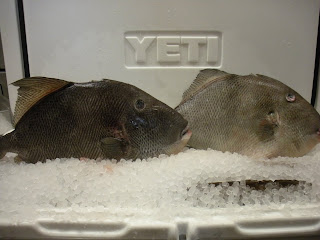The Trigger Fish
The Trigger Fish is a rather unusual character and tough as a boot. There are 40 species of the Balisidae family worldwide that are also members of the Tetraodontidae class, which links them to the Puffer Fish (or fabled Fugu or Blowfish). There are three main types found in the Gulf of Mexico: Gray, Queen and Ocean. The most common is the Gray Triggerfish, Balistes capriscus, sometimes called Leatherback or Common Turbot.
The Trigger owes its name to the series of spines that make up the dorsal fin. Once the first and largest spine is locked in an upright position no amount of pressure can force it down. The second spine, which is smaller, slides forward behind the first; the only way it can be lowered is by depressing the third spine -- the trigger. This spinal structure is used as a defense mechanism to protect the fish from attack; it also allows the fish to lock itself into a tight space. But this fish’s defensive abilities don’t stop there. The trigger is equipped with an armored body -- bony plates and a leathery skin that can wipe the edge off the sharpest knife. Even with all of this armor, it’s the Trigger’s chompers that usually garner the most attention.
The Trigger Fish is a rather unusual character and tough as a boot. There are 40 species of the Balisidae family worldwide that are also members of the Tetraodontidae class, which links them to the Puffer Fish (or fabled Fugu or Blowfish). There are three main types found in the Gulf of Mexico: Gray, Queen and Ocean. The most common is the Gray Triggerfish, Balistes capriscus, sometimes called Leatherback or Common Turbot.
The Trigger owes its name to the series of spines that make up the dorsal fin. Once the first and largest spine is locked in an upright position no amount of pressure can force it down. The second spine, which is smaller, slides forward behind the first; the only way it can be lowered is by depressing the third spine -- the trigger. This spinal structure is used as a defense mechanism to protect the fish from attack; it also allows the fish to lock itself into a tight space. But this fish’s defensive abilities don’t stop there. The trigger is equipped with an armored body -- bony plates and a leathery skin that can wipe the edge off the sharpest knife. Even with all of this armor, it’s the Trigger’s chompers that usually garner the most attention.

Trigger Teeth
And they aren’t afraid to use them. Just ask my buddy, Captain Scott, who had a chunk of his ear removed by one on a spear fishing trip. Seeing those chisel-like teeth, you can imagine that the Trigger’s diet is comprised mostly of shelled critters: barnacles, snapping shrimp, crabs, clams and mussels; they seem to have a special affinity for echinoderms (sea urchins and sand dollars). Triggers will hunt around the edges of the structures they inhabit in a vertical position and uncover the sand dollar by blowing water into the sand.
Prolific in most of the Gulf of Mexico in waters of 40-200 feet, Trigger Fish mature in 1-3 years and seem to mate randomly (and in a polygamous fashion) resulting in 50,000-100,000 eggs. Once hatched, the young race to the surface and swim into Sargassum mats. They are so dependent on the Sargassum that, in years when the seaweed is sparse, the Triggers’ overall spawn is greatly affected.
As far as fishing goes, the Trigger Fish has always been the unsung hero of the offshore trip. For years, I had trouble prying them from the captain’s hands because they were used as the crew’s bonus. I find that old adage, “You are what you eat,” applies to fish very well. The Trigger’s almost exclusive shellfish diet lends the flesh a very similar taste profile. The Trigger is very versatile with different cooking techniques -- it handles the sauté and the grill equally well. It even shines on the half-shell, showing up on Chris Shephard’s menu at Catalan frequently.






7 comments:
With those teeth, how does a trigger fish not cut the line?!
When will this be on the menu at REEF?
This is one of my favorite fish. I love their teeth - so cute!
The Trigger’s almost exclusive shellfish diet lends the flesh a very similar taste profile.
awesome blog entry and pictures
The Mighty Trigger Fish has a Face Only a Mother Could Love, I think this is true but this is a part of nature and it is some thing that we can not change, such things are really one that no good in saying.
I like all fishes but This is one my favorite dish, It's teeth seems like very dangerous,. Well it;s very tasty and many peoples like to eat with salad's.
Essays
Post a Comment